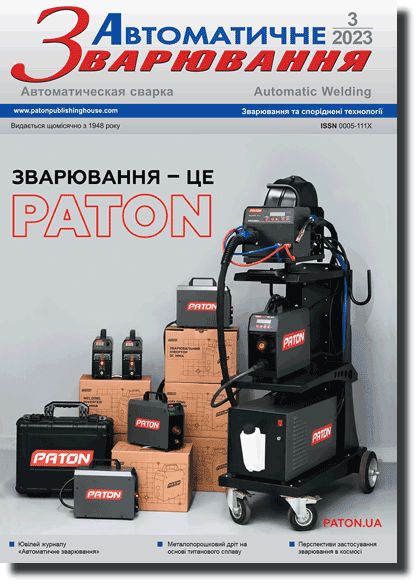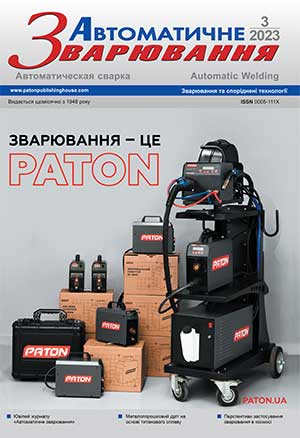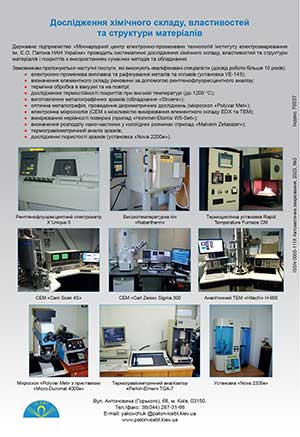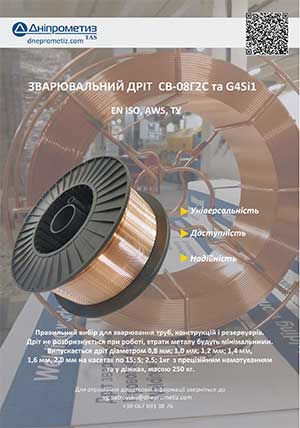| 2023 №03 (05) |
DOI of Article 10.37434/as2023.03.06 |
2023 №03 (01) |
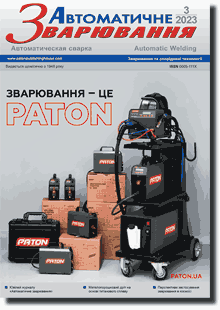
"Avtomatychne Zvaryuvannya" (Automatic Welding), #3, 2023, pp. 39-45
Hygienic characteristics and regularities of generating magnetic fields in different methods of resistance welding
O.G. Levchenko1, Yu.O. Polukarov1, O.M. Goncharova2, O.M. Bezushko2
1National Technical University of Ukraine «Igor Sikorsky Kyiv Polytechnic Institute». 37 Peremohy Ave., 03056, Kyiv, Ukraine E-mail: levchenko.opcb@ukr.net2E.O. Paton Electric Welding Institute of the NAS of Ukraine. 11 Kazymyr Malevych Str., 03150, Kyiv, Ukraine. E-mail: office@paton.kiev.ua
The levels and spectral composition of the magnetic fields generated by the equipment for resistance welding in different methods was determined in order to evaluate their effect on the body of welders. Analysis of literary sources regarding resistance welding showed almost complete lack of information on electromagnetic safety of the mentioned welding methods. The proposed methodological approaches to determination of the levels of magnetic fields, means of measurements and methods of evaluating their effect on the welder’s body are given. On the basis of the analysis and processing of the obtained oscillograms and spectrograms of magnetic fields, the measurement of their frequency and quantitative characteristics was performed. To determine the overall level of the polyfrequency magnetic field generated during resistance welding, the proposed generalized indicator of the level of the magnetic field was used. It was established that in flash-butt and capacitor-discharge spot welding, the excess of the admissible level of magnetic field is predetermined by the shape of welding current and the presence of powerful harmonic signals in the frequency ranges of 50…1000 and 1000…10000 Hz in their range. It is shown that the spectral composition and the magnitude of the magnetic field signal are determined mainly by the welding method itself and the output parameters of the power sources. It is shown that it is possible to perform flash-butt and capacitor-discharge spot welding in a stationary method with placing the workplace (control panel) at a certain distance from the welding electrodes. Unlike these methods of joining metals, flash-butt welding is not dangerous to welders. However, in manual welding, the electrode cable should not wrap around the welder’s body. 14 Ref., 3 Tabl., 2 Fig.
Keywords: flash-butt welding, magnetic field, frequency, intensity, standard, indicators, recommendations
Received: 27.03.23
References
1. Modenese, A., Gobba, F. (2021) Occupational Exposure to Electromagnetic Fields and Health Surveillance according to the European Directive 2013/35/EU. International Journal of Environmental Research and Public Health, 18(4), 1730. https://doi.org/10.3390/ijerph180417302. Stam, R. (2018) Comparison of international policies on electromagnetic fields (power frequency and radiofrequency fields). https://rivm.openrepository.com/bitstream/handle/ 10029/623629/ 2018998.pdf?sequence=1
3. Fuentes, M.A., Trakic, A., Wilson, S.J. et al. (2008) Analysis and measurements of magnetic field exposures for healthcare workers in selected MR environments. IEEE Transactions on Biomedical Engineering, 55(4), 1355-1364. https://doi.org/10.1109/TBME.2007.913410
4. Yamaguchi-Sekino, S., Ojima, J., Sekino, M., et al. (2011). Measuring exposed magnetic fields of welders in working time. Industrial health, 49(3), 274-279. https://doi.org/10.2486/indhealth.MS1269
5. Weingrill, L., Krutzler, J., Enzinger, N. (2016) Temperature Field Evolution during Flash Butt Welding of Railway Rails. Materials Science Forum, 879, 2088-2093. https://doi.org/10.4028/www.scientific.net/MSF.879.2088
6. Gotawala, N., Shrivastava, A. (2020) Microstructural analysis and mechanical behavior of SS 304 and titanium joint from friction stir butt welding. Materials Science and Engineering: A, 789, 139658. https://doi.org/10.1016/j.msea.2020.139658
7. Vates, U.K., Sharma, B.P., Kanu, N.J. et al. (2020) Optimization of Process Parameters of Galvanizing Steel in Resistance Seam Welding Using RSM. Proceedings of International Conference in Mechanical and Energy Technology. Smart Innovation, Systems and Technologies, Springer, Singapore, 7-8 November, 174. https://doi.org/10.1007/978-981-15-2647-3_65
8. Hu, S., Haselhuhn, A.S., Ma, Y. et al. (2022) Effect of external magnetic field on resistance spot welding of aluminium to steel. Science and Technology of Welding and Joining, 27(2), 84-91. https://doi.org/10.1080/13621718.2021.2013707
9. Qi, L., Zhang, Q., Niu, S. et al. (2021) Influencing mechanism of an external magnetic field on fluid flow, heat transfer and microstructure in aluminum resistance spot welding. Engineering Applications of Computational Fluid Mechanics, 15(1), 985-1001. https://doi.org/10.1080/19942060.2021.1938684
10. Levchenko, O., Polukarov, Y., Goncharova, O. et al. (2022). Determining patterns in the generation of magnetic fields when using different arc welding techniques. Eastern-European Journal of Enterprise Technologies, 2 (10 (116)), 50-56. https://doi.org/10.15587/1729-4061.2022.254471
11. Levchenko, O. (2020) Procedure of determination of multifrequency magnetic field in working zone of welder. Problemy Ohorony Pratsi v Ukraini, 36(4), 3-7. https://doi.org/10.36804/nndipbop.36-4.2020.3-7
12. Levchenko, O., Polukarov, Y., Goncharova, et al. (2022) Determining patterns in the generation of magnetic fields when using different contact welding techniques. Eastern-European Journal of Enterprise Technologies, 6(10 (120), 46-53. https://doi.org/10.15587/1729-4061.2022.268699
13. DSN 3.3.6.096-2002: Magnetic field intensity of commercial frequency (2002). Kyiv, Ministry of Health of Ukraine, 16. https://zakon.rada.gov.ua/laws/show/z0203-03#Text.
14. Tan, L., Jiang, J. (2018) Digital signal processing: fundamentals and applications. Academic Press. https:// books.google.com DwAAQBAJ&oi=fnd&pg=PP1&dq= Digital+signal+pro.ua/books?hl=ru&lr=&id=Mxlxcessing& ots=p9iTQfnj5H&sig=tqYZ9nRgZeDfoC1nvPB6thmLbxA&redir_esc=y#v=onepage&q=Digital%20signal%20 processing&f=false
Advertising in this issue:
The cost of subscription/purchase order journals or individual articles
| Journal/Currency | Annual Set | 1 issue printed |
1 issue |
one article |
| TPWJ/USD | 384 $ | 32 $ | 26 $ | 13 $ |
| TPWJ/EUR | 348 € | 29 € | 24 € | 12 € |
| TPWJ/UAH | 7200 UAH | 600 UAH | 600 UAH | 280 UAH |
| AS/UAH | 1800 UAH | 300 UAH | 300 UAH | 150 UAH |
| AS/USD | 192 $ | 32 $ | 26 $ | 13 $ |
| AS/EUR | 180 € | 30 € | 25 € | 12 € |
| SEM/UAH | 1200 UAH | 300 UAH | 300 UAH | 150 UAH |
| SEM/USD | 128 $ | 32 $ | 26 $ | 13 $ |
| SEM/EUR | 120 € | 30 € | 25 € | 12 € |
| TDNK/UAH | 1200 UAH | 300 UAH | 300 UAH | 150 UAH |
| TDNK/USD | 128 $ | 32 $ | 26 $ | 13 $ |
| TDNK/EUR | 120 € | 30 € | 25 € | 15 € |
AS = «Automatic Welding» - 6 issues per year;
TPWJ = «PATON WELDING JOURNAL» - 12 issues per year;
SEM = «Electrometallurgy Today» - 4 issues per year;
TDNK = «Technical Diagnostics and Non-Destructive Testing» - 4 issues per year.





